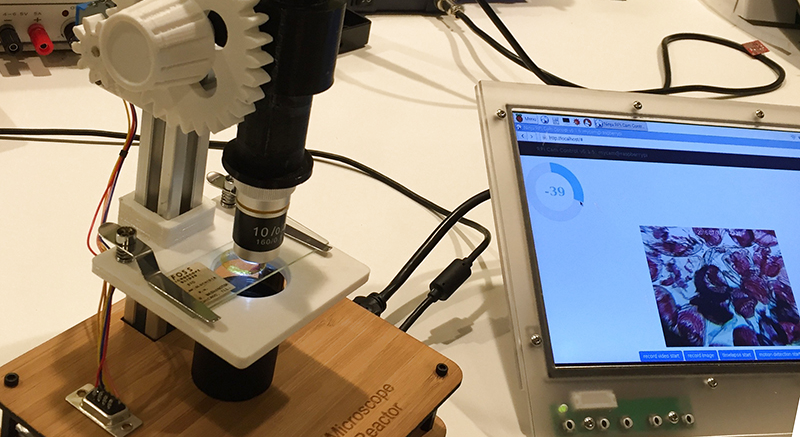For their entry into the Citizen Scientist portion of the Hackaday Prize, the folks at Arch Reactor, the St. Louis hackerspace, are building a microscope. Not just any microscope – this one is low-cost, digital, and has a surprisingly high magnification and pretty good optics. It’s the Internet of Things Microscope, and like all good apparatus for Citizen Scientist, it’s a remarkable tool for classrooms and developing countries.
When you think of ‘classroom microscope’, you’re probably thinking about a pile of old optics sitting in the back of a storage closet. These microscopes are purely optical, without the ability to take digital pictures. The glass is good, but you’re not going to get a scanning stage when you’re dealing with 30-year-old gear made for a classroom full of sticky-handed eighth graders.
The Internet of Things Microscope includes a scanning stage that moves across the specimen on the X and Y axes, stitching digital images together to create a very large image. That’s a killer feature for a cheap digital microscope, and the folks at Arch Reactor are doing this with a few cheap stepper motors and stepper motor drivers.
The rest of the electronics are built around a Raspberry Pi, Raspberry Pi camera (which recently got a nice resolution upgrade), and a some microscope eyepieces and objectives. Everything else is 3D printed, making this a very cheap and very accessible microscope that has some killer features.





















Whatever happened to Foldscope?
I was on the mailing list, but I never got one. :(
But why is it IoT? IoT is anti-maker/diy. Don’t buy into the hype.
“I like to make stuff by myself. Except data storage and file transfer. I leave that to the faceless people on the internet.”
I’m glad I’m not the only one who sees IoT as primarily a scheme to transition consumer electronics to a service/subscription model.
That’s a bit rediculous. The phony corps perverting IoT is no different than the phony corps perverting hacking/making in general. They didn’t come up with the concepts and they won’t use them for any real purpose either. They are not us. IoT is our idea. We just used to call it “linux on a toaster”.
Dang wordpress. This UI is terrible. I’d like to add to my previous comment that although co-opting IoT is no different than co-opting making, this project is not IoT.
IoT is a machine with a well-defined API, and a “mind” that API interfaces with. This may be an IP microscope, but unless it’s capable of doing things such as providing useful statistics and interfaces to other machines, it is not an Internet Thing.
that’s all in the software, which still being developed and will be extensible. there no reason you couldn’t put some image processing on it and have multiple ‘scopes scanning dishes and reporting back their analysis to a main controller.
IoT just means it’s a thing that you traditionally wouldn’t have talking on the network connected up in some way.
in this case the IoT aspect is that the interface is web based. you can leave the microscope on the table, or ground, or where it’s convenient to have it, and use a browser on a tablet or PC to view and control it.
Something I’ve always thought is that kids in third-world countries don’t need microscopes at all. Seriously, in middle/high school I can only remember a handful of times where we touched microscopes, and everything we did with them was basically done to justify them being there. All the stuff we did do could be easily done in software as well!
You see pictures of these classrooms, and they don’t have doors, chairs, tables, whatever. How is a microscope supposed to help these kids?
I disagree somewhat. Students in the ‘third world’ don’t have a good reason to go onto field trips to museums or have an advanced chemistry lab.
Microscopes encourage research in biological and medical fields, which is something they are usually in short supply of. (Doctors, nurses, Malaria specialist…)
While I think IoT IS a buzzword around these parts, in this case it is different.
A person can set up a slide with parasites so that dozens can see why they shold boil their water. And they get to see it up close, not on some blurry projection.
I’d love to additionally see focus stacking to allow for a wider depth of field to make the microscope images really look amazing.
We are looking at ways to do z-stacking and x/y stitching. It was beyond the reach of our basic concept, but we plan on including it in more advanced versions.
I admit IoT is stretching the term a little bit. It refers to the ability to use the microscope over the internet and that it is a thing. Perhaps internet-enabled is a better fit, but not as intuitive. Not exactly the traditional definition, but it does fit. We are looking into many uses for different people as well. We are certainly trying to make sure Makers are taken care of. We are exploring using our prize to make kits for people to build on a variety of different levels based on how much you want to do yourself.
-Arch Reactor